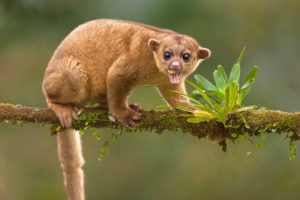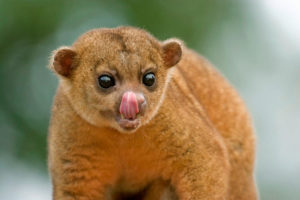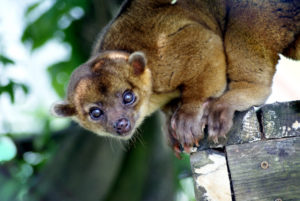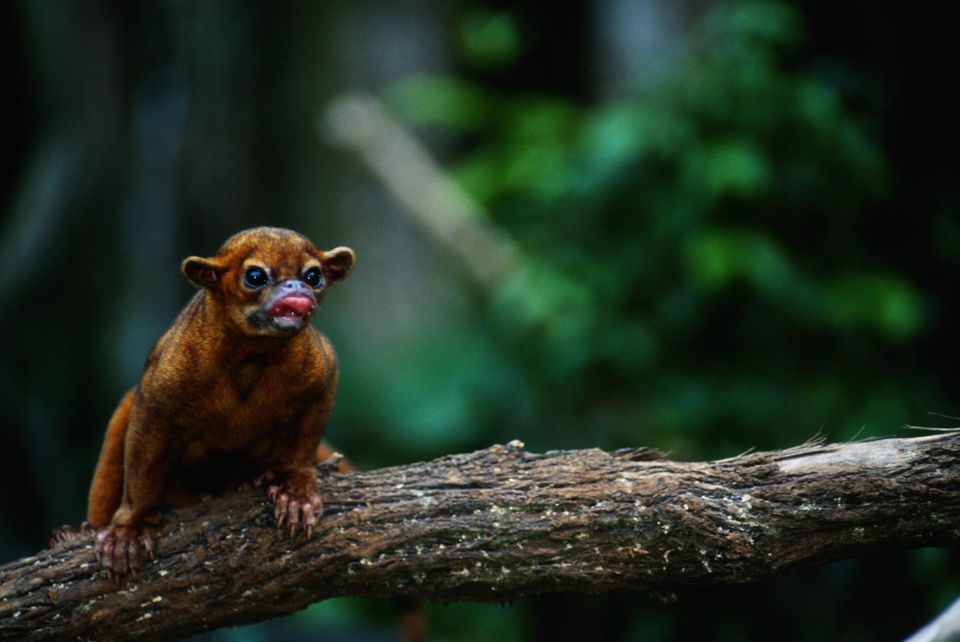Kinkajous are small mammals that belong to the raccoon family. There are 7 subspecies of kinkajou that can be found in southern Mexico and in Central and South America. They mostly live in tropical rainforests, mountain forests and dry forests. Take a look below for 25 more interesting and fun facts about kinkajous.
1. In some countries, kinkajous are kept as house pets.
2. They can grow up to between 16 and 30 inches in length, with a tail that’s between 15 and 22 inches long. Fully grown kinkajous weigh between 3 and 10 pounds.
3. They have a wooly fur that consists of a golden outer coat and a grey undercoat.
4. They’re known for their big eyes, small ears and short legs with sharp claws on their feet. Some people call them “honey bears” because it looks somewhat like a bear cub that likes to eat honey.
5. Kinkajous can rotate their ankles on their hind feet backwards, which allows them to easily move in the treetops and to move up and down along tree trunks.
6. They have prehensile tails that act like an additional arm. They use their tails to hold onto branches and to balance when they’re moving in the treetops. Sometimes, they even wrap their tails around their body and use it as a blanket.

7. They’re nocturnal creatures, which means that they’re the most active during the night. During the day, it will hide in tree holes.
8. They’re omnivores, which means that their diet is plant and animal based. Their diet consists of figs, melons, mangoes, apples, bananas, insects, birds and their eggs, and small mammals.
9. They use their 5 inch long, skinny tongue to extract nectar from flowers. It collects and transfers pollen from one flower to another while drinking nectar. This makes kinkajous very important in successfully pollinating the ecosystem.
10. Their main predators are jaguars, ocelots, tayras, foxes and harpy eagles.
11. They’re solitary creatures, but they like to forage and sleep in small groups. They also groom each other in small groups.
12. They’re known for barking, screaming, hissing and producing high pitched squeaks. In Spanish, kinkajous are sometimes known as “la llorona” or “crying woman” due to their unusual noises.
13. Kinkajous are territorial animals and they will use glands located near their mouth, throat and belly to mark their territory.
14. They’re able to reproduce during the entire year. Female kinkajous will be pregnant from 112 to 118 days, and the pregnancy will end with 1 maybe 2 cubs.

15. Kinkajou offspring are blind, deaf and helpless at birth. The mother kinkajou is very protective and is known to travel with the offspring attached to her belly.
16. Male kinkajous reach sexual maturity when they’re 18 months old, which female kinkajous will reach sexual maturity when they’re 30 months old.
17. Kinkajous don’t like sudden movements, noise, and being awake during the day. An agitated kinkajou may emit a scream and attack, usually clawing its victim and sometimes biting.
18. In 2011, the Centers for Disease Control and Prevention reported that pet kinkajous in the United States can be carriers of the raccoon roundworm, Baylisascaris procyonis, which is capable of causing severe morbidity and even death in humans.
19. In El Salvador, Guatemala and Honduras, pet kinkajous are called “micoleon”, meaning “lion monkey.”
20. In Peru, pet kinkajous are called “liron”, which means “bear monkey” or “bear monkey hybrid.”
21. The average lifespan for a captive kinkajou is between 20 and 23 years. However, the oldest recorded kinkajou was 41 years old.
22. Kinkajous evolved in Central America and invaded the formerly isolated continent of South America 7 million years ago, as part of the Great American Interchange, when the formation of the Isthmus of Panama made it possible.

23. They’re not an endangered species, though they’re rarely seen by people because of their strict nocturnal habits.
24. They’re one of only two carnivores that have a prehensile tail, the other is the binturong.
25. Kinkajous are heavily hunted by humans for their fur and for the exotic pet industry.




